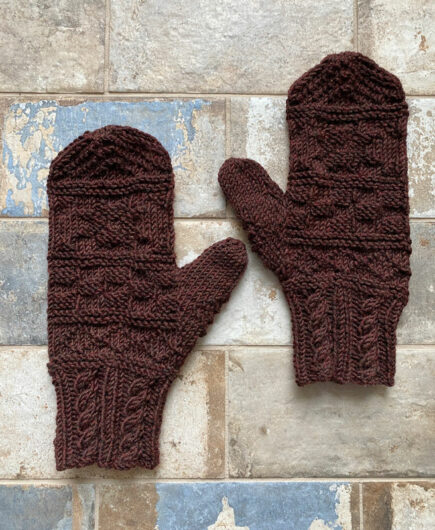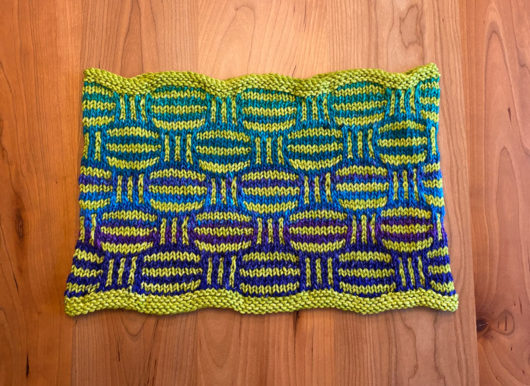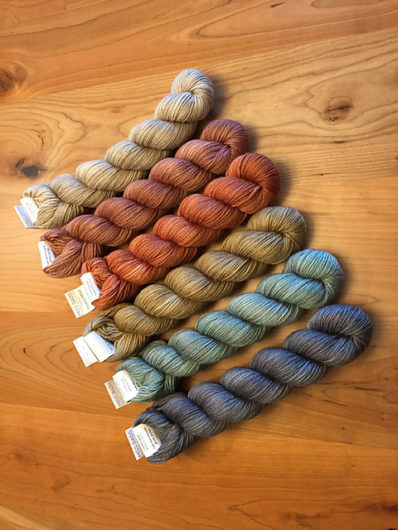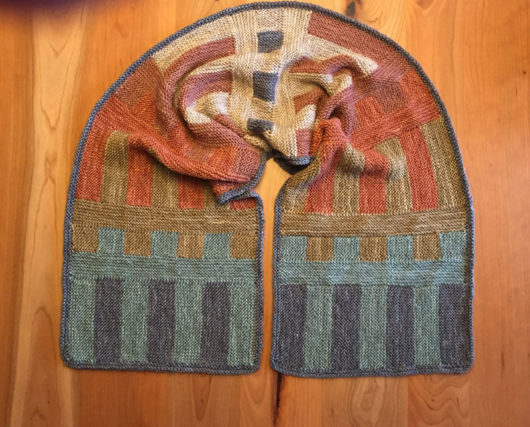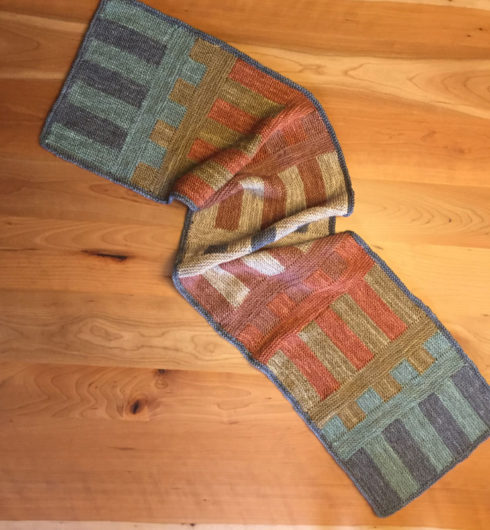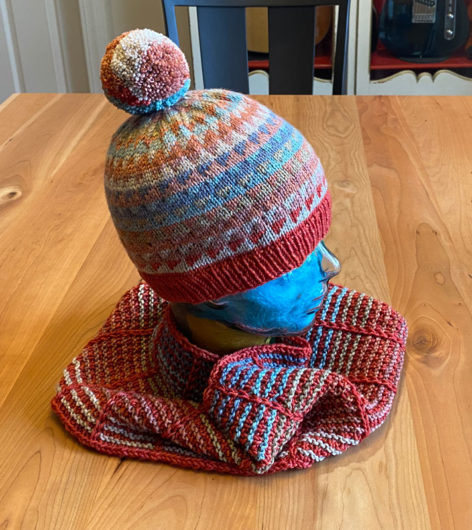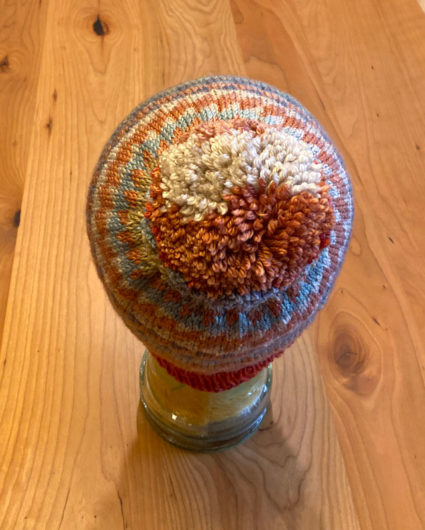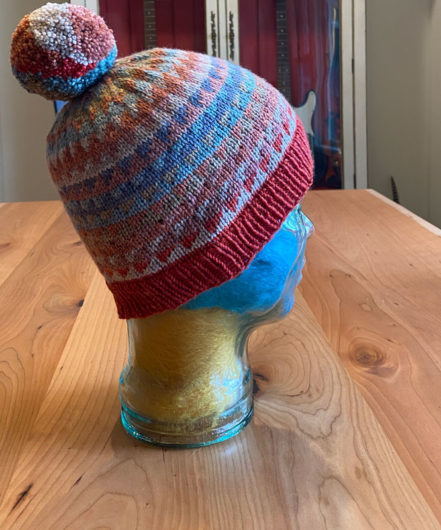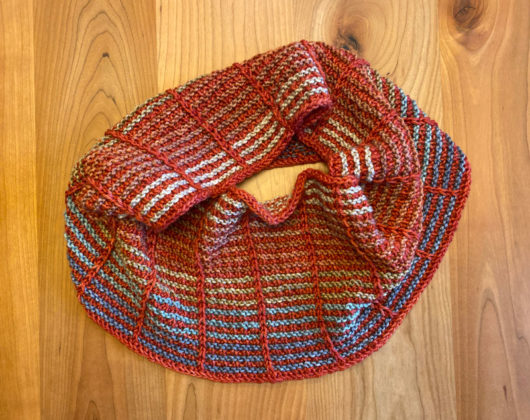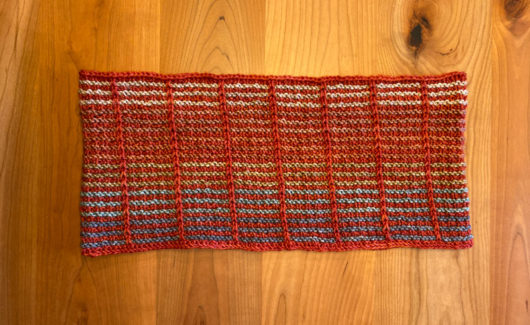
Here’s Barley. It’s part of tincanknits wonderful Simple Collection, a freebie set of patterns aimed at beginning knitters. The patterns work equally well for experienced knitters looking for a relaxing rewarding knit. This is Barley the hat, not to be confused with Grain the shawl, Harvest the cardigan, Maize the fingerless mitts, Rye the socks, Oats the cowl, Flax the pull-over sweater, Malt the blanket, or Wheat the scarf. The patterns come in multiple sizes and are designed for worsted weight. But some of the patterns, including the hat, the pullover and the socks, also have lightweight versions.
It’s such a generous gift to the knitting universe. I knit this Barley in excellent worsted weight with possibly the longest name in the knitting universe: West Yorkshire Spinners Bluefaced Leicester Aran Prints. It’s the Blue Tit colorway.

Aptly named.
Here’s a look at the crown decreases complete with a pompom.

Why knit doubles? It’s a legitimate question for sure. I enjoy seeing how the same pattern knits up in different yarns. And if a pattern reliably produces a good result, I enjoy that predictability. I will especially retreat into that predictability if I’ve just finished a knit that I’m not completely satisfied with.
So, next up is Barley knit again, this time in Dark Pink from Novita 7 Veljesta Solid.

Here’s another look at Barley’s crown, this time not obscured by a pompom.

Neat and organized as any good crown should be. Barley gives a new knitter the chance to practice garter stitch in the round. It also builds skills in terms of learning to read your knitting.
Next up is Nici Griffin’s Escape Beanie. There’s a cowl and fingerless mitts that complete the set if you’re into sets. Personally I’ve always favored a mishmash look in my handknits. But lately this aged hippie is starting to see the value of sets.
This first Escape is knit in Shalimar Yarns Breathless DK. Drat. Yet another wonderful yarn you can’t buy anymore: 75% merino, 15% cashmere, 10% silk. I unraveled a little-used small shawl and knitted up part of the yarn in this Escape.

Here’s another Escape, this time knit in Schachenmayr Merino Extrafine 120, another excellent DK weight yarn. This DK is beefier than Breathless. I needed 54 grams of yarn and only had 50 grams of the Royal colorway. You probably spotted right away what my solution was.

Here’s a closer look at its bullseye top.

I’m actually quite satisfied with my solution. Before changing colors, I knit one round so that I’d avoid any of those half-one-color-half-another stitches. That round fades nicely into the pattern. No worries. Embracing one’s lemons can yield good results.
Next up is yet another in a series of Just a Hat‘s I’ve knit. It’s such an excellent unisex hat, a freebie from Galina Shemchuk. Shemchuk’s pattern used to be downloadable on Ravelry and savable to your Rav library. No more. Fairly recently she took the unusual step of photographing the pattern and adding it to the project page in that form. A little odd, but it works.

I knit this Just a Hat, my 5th, in Sugar Bush Yarn’s Bold. This is the Sultry Dusk colorway. Some skeins of this excellent superwash worsted may still be available for purchase, especially in the variegated colorways. But it too is now discontinued.

One more double today. My 6th Just a Hat, this time knit in Viking of Norway Raggen, another superwash worsted. Good news. Raggen isn’t discontinued. When it happens, this knitter won’t mourn its passing though. I found it splitty and sometimes the plies even unraveled as I knit. Maybe I got a defective skein. Two skeins, actually.

Nice hat, though. And in a hat maybe Raggan won’t pill as badly as it’s pilling in a pair of socks I knit with it. Just in case you want to see a solid color crown, have a gander.

Did I really just use the word gander? No, we will not talk about geese, ganders, or goslings on this blog. It’s almost mid March. I’ve already seen Canada Geese overhead no doubt scouting out places to land and nest. “Nothing to see here…move along, move along.”











